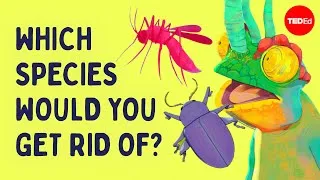How a dragonfly's brain is designed to kill | DIY Neuroscience, a TED series
854,791 views ・ 2018-09-15
請雙擊下方英文字幕播放視頻。
00:00
Translator: Joseph Geni
Reviewer: Joanna Pietrulewicz
0
0
7000
譯者: Joey Chung
審譯者: Helen Chang
00:12
Greg Gage: If I asked you
to think of a ferocious killer animal,
1
12200
3056
葛列格·蓋奇 (GG):如果讓
你想像兇猛的捕食動物,
00:15
you'd probably think of a lion,
2
15280
1496
你可能會想到獅子,
00:16
and for all the wonderful
predatory skills that a lion has,
3
16800
2816
但即使獅子捕食技巧出色,
00:19
it still only has about a 20 percent
success rate at catching a meal.
4
19640
3696
牠捕食的成功率也只有兩成。
00:23
Now, one of the most successful hunters
5
23360
2016
要說動物王國中最成功的捕食者,
00:25
in the entire animal kingdom
is surprising:
6
25400
2056
答案可能會讓你大吃一驚,
00:27
the dragonfly.
7
27480
1256
是蜻蜓。
00:28
Now, dragonflies are killer flies,
8
28760
1776
蜻蜓是飛行獵手,
00:30
and when they see a smaller fly,
9
30560
1576
當牠們看到比自身體型小的飛蟲,
00:32
they have about a 97 percent
chance of catching it for a meal.
10
32160
2976
有 97% 的概率能捕捉到作為食物。
00:35
And this is in mid-flight.
11
35160
1256
而整個過程可以在飛行中完成。
00:36
But how can such
a small insect be so precise?
12
36440
3176
一隻如此小的昆蟲
為何有如此高的精準度?
00:39
In this episode, we're going to see
13
39640
1856
在這一集中,我們將會看到
00:41
how the dragonfly's brain is highly
specialized to be a deadly killer.
14
41520
3680
蜻蜓的大腦如何讓牠成為致命殺手。
00:45
[DIY Neuroscience]
15
45224
3231
[DIY 神經科學]
00:48
So what makes the dragonfly
one of the most successful predators
16
48480
3016
蜻蜓是如何成為動物中
最成功的捕食者之一呢?
00:51
in the animal kingdom?
17
51520
1216
00:52
One, it's the eyes.
18
52760
1256
第一,是牠的眼睛構造。
00:54
It has near 360-degree vision.
19
54040
1856
蜻蜓擁有接近 360° 的視角。
00:55
Two, the wings.
20
55920
1416
第二,翅膀結構。
00:57
With individual control of its wings,
21
57360
1816
通過對翅膀的獨立控制,
00:59
the dragonfly can move
precisely in any direction.
22
59200
2376
蜻蜓可以在任何方向精確移動。
01:01
But the real secret
to the dragonfly's success
23
61600
2376
但蜻蜓成功的真正秘訣
01:04
is how its brain coordinates
this complex information
24
64000
3096
是其大腦可以整合來自眼睛
01:07
between the eyes and the wings
25
67120
1536
和翅膀的複雜信號
01:08
and turns hunting into a simple reflex.
26
68680
2576
並將捕獵行為轉變為簡單反射。
01:11
To study this, Jaimie's been
spending a lot of time
27
71280
2381
為了研究當中的原理,
傑米花了很多時間
01:13
socializing with dragonflies.
28
73685
1651
和蜻蜓相處。
01:15
What do you need to do your experiments?
29
75360
1936
你做實驗需要些什麼?
01:17
Jaimie Spahr: First of all,
you need dragonflies.
30
77319
2337
傑米·斯帕爾:首先,你需要蜻蜓。
01:19
Oliver: I have a mesh cage
to catch the dragonflies.
31
79680
2456
奧利弗: 我用捕蟲網去捉牠們。
01:22
JS: The more I worked with them,
the more terrified I got of them.
32
82160
3136
傑米:越研究牠們,就越害怕牠們。
01:25
They're actually very scary,
especially under a microscope.
33
85320
2776
牠們實際上非常嚇人,
特別是在顯微鏡下。
01:28
They have really sharp mandibles,
are generally pretty aggressive,
34
88120
3136
牠們的下頜骨非常鋒利,
而且很有攻擊性,
01:31
which I guess also helps them
to be really good predators.
35
91280
2736
我相信這幫助牠們成為捕食好手。
01:34
GG: In order to learn what's going on
inside the dragonfly's brain
36
94040
3136
GG:為了進一步研究
當蜻蜓看到獵物時的大腦活動,
01:37
when it sees a prey,
37
97200
1216
我們決定偷聽蜻蜓
01:38
we're going to eavesdrop in
on a conversation
38
98440
2136
眼睛和翅膀間的對話,
01:40
between the eyes and the wings,
39
100600
1536
為此,我們需要用冰塊麻醉蜻蜓,
01:42
and to do that, we need
to anesthetize the dragonfly on ice
40
102160
2762
01:44
and make sure we protect its wings
so that we can release it afterwards.
41
104946
3390
並確保翅膀完好無損,
以便我們之後放走牠。
蜻蜓大腦中有很多
特殊的細胞,即是神經元
01:48
Now, the dragonfly's brain is made up
of specialized cells called neurons
42
108360
3656
01:52
and these neurons
are what allow the dragonfly
43
112040
2176
而就是這些神經元讓蜻蜓
能夠快速見到物件和移動。
01:54
to see and move so quickly.
44
114240
1656
01:55
The individual neurons form circuits
by connecting to each other
45
115920
3056
獨立的神經元通過細長的軸突
01:59
via long, tiny threads called axons
46
119000
2616
連接彼此,
02:01
and the neurons communicate
over these axons using electricity.
47
121640
3256
進而組成神經迴路,
在軸突上用電信號進行交流。
02:04
In the dragonfly, we're going to place
little metal wires, or electrodes,
48
124920
3456
在蜻蜓體內,我們將沿著軸突
放置一些小的金屬線和電極,
02:08
along the axon tracks,
49
128400
1256
02:09
and this is what's really cool.
50
129680
1496
這整個過程很酷。
02:11
In the dragonfly, there's only 16 neurons;
51
131200
2016
在蜻蜓體內只有 16 個神經元:
02:13
that's eight per eye
52
133240
1256
每隻眼睛有 8 個,
02:14
that tell the wings
exactly where the target is.
53
134520
2456
用來告訴翅膀目標的具體方位。
02:17
We've placed the electrodes
so that we can record from these neurons
54
137000
3216
放置電極後,我們就可以記錄
眼睛和翅膀之間的神經元電信號。
02:20
that connect the eyes to the wings.
55
140240
1696
02:21
Whenever a message is being passed
from the eye to the wing,
56
141960
2856
每當有訊息從眼睛傳遞到翅膀,
02:24
our electrode intercepts that conversation
in the form of an electrical current,
57
144840
3736
我們的電極都會將這次對話
以電流的形式記錄下來,
02:28
and it amplifies it.
58
148600
1216
並放大電流。
02:29
Now, we can both hear it and see it
in the form of a spike,
59
149840
3056
我們能看到並聽到電流脈衝,
02:32
which we also call an action potential.
60
152920
2256
我們稱之為動作電位。
02:35
Now let's listen in.
61
155200
1256
現在一起來聽聽。
02:36
Right now, we have the dragonfly
flipped upside down,
62
156480
3456
我們馬上把蜻蜓倒置,
02:39
so he's looking down towards the ground.
63
159960
2616
牠現在眼朝地面。
02:42
We're going to take a prey,
or what we sometimes call a target.
64
162600
2976
我們現在放置一個獵物,或者說目標,
02:45
In this case, the target's
going to be a fake fly.
65
165600
2496
這裡我們使用一隻假蒼蠅作為目標。
02:48
We're going to move it
into the dragonfly's sights.
66
168120
2520
我們將在蜻蜓的視野範圍內移動牠。
02:52
(Buzzing)
67
172640
1656
(電流聲)
02:54
Oh!
68
174320
1200
哦!
02:56
Oh, look at that.
69
176720
1200
哦,你看這裡。
03:02
Look at that, but it's only
in one direction.
70
182040
2200
快看這裡,但只在
朝特定方向時發生電位變化。
03:04
Oh, yes!
71
184840
1240
哦,好!
03:06
You don't see any spikes
when I go forward,
72
186640
2056
當我向前移動時,不會出現任何脈衝,
03:08
but they're all when I come back.
73
188720
1896
但回來的時候脈衝會出現。
03:10
In our experiments,
74
190640
1456
在實驗中,
03:12
we were able to see
that the neurons of the dragonfly
75
192120
2496
我們見到當目標僅朝一個方向移動時,
蜻蜓的神經元會被啟動,
03:14
fired when we moved the target
in one direction but not the other.
76
194640
3256
但在向另一個方向移動時卻沒有。
03:17
Now, why is that?
77
197920
1256
這是為什麼呢?
03:19
Remember when I said that the dragonfly
78
199200
1858
記得我之前提及到
蜻蜓擁有 360° 的可視範圍。
03:21
had near 360-degree vision.
79
201082
2054
03:23
Well, there's a section
of the eye called the fovea
80
203160
2496
同時,蜻蜓眼睛上有一個
稱為中央凹的區域
03:25
and this is the part
that has the sharpest visual acuity,
81
205680
2896
而這也是蜻蜓視力最敏銳的部分,
03:28
and you can think of it as its crosshairs.
82
208600
2696
你可以把它看作瞄準線。
03:31
Remember when I told you the dragonfly had
individual precise control of its wings?
83
211320
4176
還記得我給你說過蜻蜓能獨立
控制每個翅膀嗎 ?
03:35
When a dragonfly sees its prey,
it trains its crosshairs on it
84
215520
4056
當蜻蜓發現獵物時
會試圖將瞄準線對準獵物,
03:39
and along its axons
it sends messages only to the neurons
85
219600
3376
會沿著軸突發送訊號給
控制翅膀的神經元
來對準目標。
03:43
that control the parts of the wings
86
223000
1696
03:44
that are needed
to keep that dragonfly on target.
87
224720
2336
03:47
So if the prey is
on the left of the dragonfly,
88
227080
2976
所以,如果獵物在蜻蜓的左側,
03:50
only the neurons that are tugging
the wings to the left are fired.
89
230080
3776
那麼只有控制左側翅膀的
神經元會被啟動。
03:53
And if the prey moves
to the right of the dragonfly,
90
233880
2496
如果獵物飛向蜻蜓的右側,
03:56
those same neurons are not needed,
so they're going to remain quiet.
91
236400
3176
那就不需要這些神經元了,
它們就會在靜止狀態。
03:59
And the dragonfly speeds toward the prey
92
239600
1936
當神經元確定好翅膀的角度後,
04:01
at a fixed angle that's communicated
by this crosshairs to the wings,
93
241560
3256
蜻蜓會依照瞄準線朝獵物飛去。
04:04
and then boom, dinner.
94
244840
2016
一擊直中,晚餐到手。
04:06
Now, all this happens in a split second,
and it's effortless for the dragonfly.
95
246880
3696
現在,這些都是一瞬間發生的事,
這對蜻蜓來說不費吹灰之力,
04:10
It's almost like a reflex.
96
250600
1576
就像本能反應。
04:12
And this whole incredibly efficient
process is called fixation.
97
252200
4096
而這個驚人高效的捕獵過程
被稱為固定(fixation)。
04:16
But there's one more
story to this process.
98
256320
2616
但是還有一件需要考慮的事情。
04:18
We saw how the neurons
respond to movements,
99
258960
2096
我們看到神經元如何回應運動,
04:21
but how does the dragonfly know
that something really is prey?
100
261080
2920
但是蜻蜓如何判斷誰是獵物呢?
04:24
This is where size matters.
101
264880
1336
這就需要考慮獵物的體型了。
04:26
Let's show the dragonfly a series of dots.
102
266240
2520
讓我們來給蜻蜓展示一系列圓點。
04:41
Oh, yeah!
103
281000
1216
哦,對了!
04:42
JS: Yeah, it prefers that one.
104
282240
2216
傑米:對,牠對那個比較有反應。
04:44
GG: Out of all the sizes,
105
284480
1256
GG: 在所有的體型中,
04:45
we found that the dragonfly responded
to smaller targets over larger ones.
106
285760
3520
我們發現蜻蜓更傾向於
選擇體型小的目標。
04:49
In other words, the dragonfly
was programmed to go after smaller flies
107
289680
4056
換句話說,蜻蜓被設定為
捕捉體型比自己小的飛蟲,
04:53
versus something much larger, like a bird.
108
293760
2336
而不是更大的目標,比如鳥類。
04:56
And as soon as it recognizes
something as prey,
109
296120
2576
而只要牠識別出了獵物,
04:58
that poor little fly
only has seconds to live.
110
298720
2816
那隻可憐的小飛蟲
只有幾秒鐘的逃生時間。
05:01
Today we got to see
how the dragonfly's brain works
111
301560
2576
今天我們看到了蜻蜓的腦如何工作
05:04
to make it a very efficient killer.
112
304160
1680
使得蜻蜓成為一個高效的獵手。
05:06
And let's be thankful
that we didn't live 300 million years ago
113
306440
3736
而且我們要慶幸
自己不是生活在 3 億年前,
05:10
when dragonflies were the size of cats.
114
310200
2880
那時的蜻蜓跟貓一樣大。
New videos
Original video on YouTube.com
關於本網站
本網站將向您介紹對學習英語有用的 YouTube 視頻。 您將看到來自世界各地的一流教師教授的英語課程。 雙擊每個視頻頁面上顯示的英文字幕,從那裡播放視頻。 字幕與視頻播放同步滾動。 如果您有任何意見或要求,請使用此聯繫表與我們聯繫。







